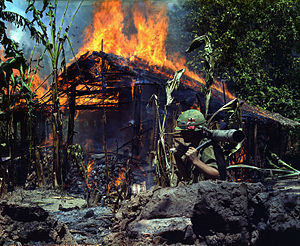
| Part of a series on |
| War (outline) |
|---|
 |
Asymmetric warfare (or asymmetric engagement) is a type of war between belligerents whose relative military power, strategy or tactics differ significantly. This type of warfare often, but not necessarily, involves insurgents, terrorist groups, or resistance militias operating within territory mostly controlled by the superior force.[1][2][3]
Asymmetrical warfare can also describe a conflict in which belligerents' resources are uneven, and consequently, they both may attempt to exploit each other's relative weaknesses. Such struggles often involve unconventional warfare, with the weaker side attempting to use strategy to offset deficiencies in the quantity or quality of their forces and equipment.[4] Such strategies may not necessarily be militarized.[5] This is in contrast to symmetrical warfare, where two powers have comparable military power, resources, and rely on similar tactics.
Asymmetric warfare is a form of irregular warfare – conflicts in which enemy combatants are not regular military forces of nation-states. The term is frequently used to describe what is also called guerrilla warfare, insurgency, counterinsurgency, rebellion, terrorism, and counterterrorism.
- ^ Luyt, Brendan (2015-05-11). "Debating reliable sources: writing the history of the Vietnam War on Wikipedia". Journal of Documentation. 71 (3): 440–455. doi:10.1108/jd-11-2013-0147. ISSN 0022-0418.
- ^ "School of Advanced Military Studies Monographs". cgsc.contentdm.oclc.org. Retrieved 2024-11-15.
- ^ "Asymmetry Is Strategy, Strategy Is Asymmetry". National Defense University Press. Retrieved 2024-11-15.
- ^ Tomes, Robert (Spring 2004). "Relearning Counterinsurgency Warfare" (PDF). Parameters. Archived from the original (PDF) on 2010-06-07.
- ^ Stepanova, E. 2008 Terrorism in asymmetrical conflict: SIPRI Report 23 (PDF). Oxford Univ. Press. Archived from the original (PDF) on 2016-03-10. Retrieved 2016-03-19.